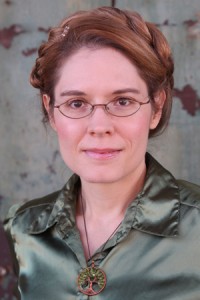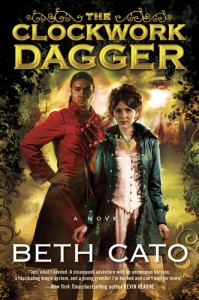10 Things To Know About The Clockwork Dagger
 Frequent Niteblade contributor Beth Cato‘s novel launched today and in order to help her celebrate we’re pleased to share this guest post —
Frequent Niteblade contributor Beth Cato‘s novel launched today and in order to help her celebrate we’re pleased to share this guest post —
10 Things to Know About The Clockwork Dagger
#1: It’s not on Earth, but it’s still historical fiction.
The technology, fashion, and grimness are based on post-World War I Europe. This influences everything from the steam cabriolets on the street to the suspicion that the meat at lunch isn’t beef, but horse.
#2: Medicians use healing magic.
My heroine, Octavia Leander, is trained as a healing magi and as a traditional doctor. She uses blessed herbs to draw on the power of the Lady’s Tree.
#3: The Lady is a world tree.
Most people in Octavia’s society regard the Lady as a figure of mythology. They scoff at the idea of a gigantic tree whose roots moor the world and whose omnipresence touches all life on the continent. Octavia fervently believes, but then, her connection to the Lady is quite unusual.
#4: It’s a colorful world.
Caskentia and the surrounding kingdoms and city-states are populated by various skin colors and cultures.
#5: The geography is inspired by eastern Washington.
Familiarity makes for a more realistic world. I lived north of Seattle for several years while my husband was in the Navy, and I miss the area. The topography within the book is similar to that of Mount Vernon on down toward Portland, with additional cameos by Mount Rainier and dry eastern Washington.
#6: There’s a touch of romance.
The chemistry is there, but it’s not the focus of the book. Octavia’s real priority is to stay alive and keep others alive, too.
#7: Old school RPGs play a role, too.
Final Fantasy IV, VI and Secret of Mana were my obsessions as a teenager and their influence has never left me. The Lady is directly inspired by Secret of Mana. Old school gamers will recognize tiny homages hidden within the book.
#8: The Hindenburg helped me out.
I wanted to create a realistic airship for the action in The Clockwork Dagger. The Hindenburg is both tragic and infamous, and there’s extensive resource material to draw from. My airship the Argus uses the Hindenburg’s floor plan cut in half, but many of the room details are almost exact. One significant modification: the boost of aether magic to keep it afloat.
#9: Gremlins FTW.
When I created my own sort of gremlins, I had no idea that the ugly-cute green-skinned critters would become one of the main appeals of the book.
#10: Agatha Christie contributed to the plot.
My mom raised me on Hercule Poirot and Miss Marple mysteries. My initial idea for The Clockwork Dagger was “Murder on the Orient Express, on an airship.” Everything else built from there.
The Clockwork Dagger is available today at all the usual suspects:
~ Amazon ~ Barnes & Noble ~ Powell’s ~ Books-A-Million ~
About the Author:
Beth Cato hails from Hanford, California, but currently writes and bakes cookies in a lair west of Phoenix, Arizona. She shares the household with a hockey-loving husband, a numbers-obsessed son, and a cat the size of a canned ham.
Beth’s short fiction can be found in Orson Scott Card’s InterGalactic Medicine Show, Beneath Ceaseless Skies, and many other magazines. The Clockwork Dagger is her first novel. The sequel, The Clockwork Crown, will be released in 2015.
Follow her at www.BethCato.com and on Twitter at @BethCato.

As if I wasn’t looking forward to reading my copy already.